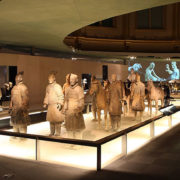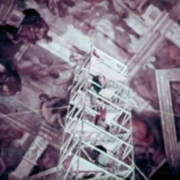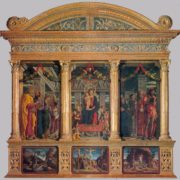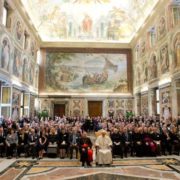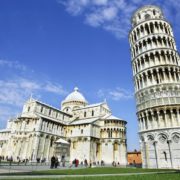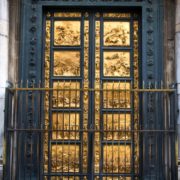Masaccio’s Trinity: The Tyranny of the Fragment
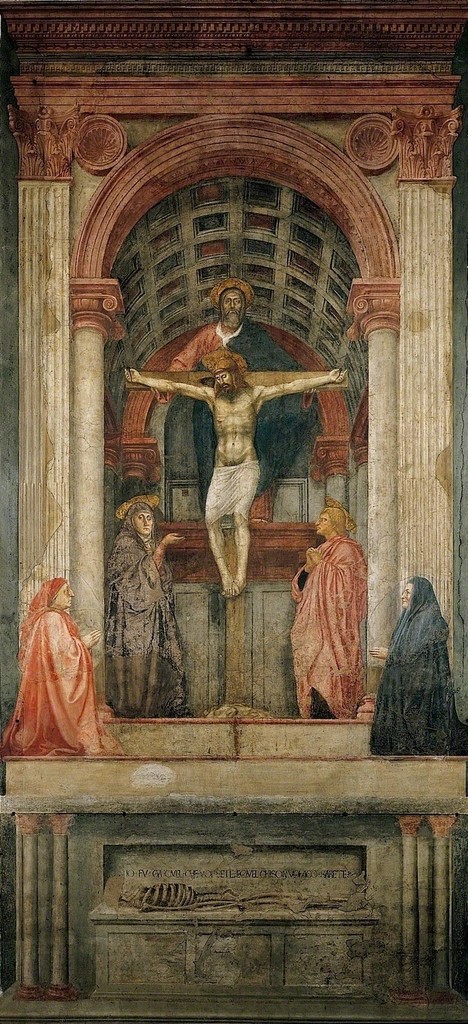
Masaccio, Trinity with the Virgin, Saint John the Evangelist, and Donors, c. 1425-27/28. Church of Santa Maria Novella (Florence).
The Direction of the Opificio delle Pietre Dure in Florence graciously permitted me to visit the ongoing restoration of Masaccio’s Trinity, in Santa Maria Novella, on Thursday August 31st, 2000.
In interviews published in Florentine and Torinese newspapers I had publicly lamented the restoration. My objections, in part, were based upon a firm conviction that the mere decision alone to carry on this restoration represented a cultural presumption one which aims at dramatically altering the appearance of the painting as we have come to know it. No broad consensus about taking this step had been developed, not to mention calling was an international meeting or conference of specialists and interested parties. The step to intervene was taken unilaterally. But still more crucial to my disappointment, one has to look in vain for a carefully calibrated statement, or any statement at all for that matter, regarding the need of the “drastic” (the word used by the Opificio official in charge of the operation) intervention nor its goals, which should precede any such work. We have no reports concerning the painting following a restoration by the late Leonetto Tintori, conducted at the beginning of the 1960s. Furthermore a statement about the methodology proposed, if one exists, should have been made public, in my opinion. All the procedures used normal by a medical intervention, for example, were passed over, at least according the information I have been able to obtain. The Opificio, presumably with permission from the appropriate Florentine superintendencies, decided to move ahead without the formalities mentioned. Apparently an occasion offered itself: the church had been closed for an overall, elaborate scrub down as part of the Jubilee Year celebrations. Why not do the Trinity, was the thinking, I can only guess.
My purpose here is not to rehearse the history of the fresco and its various restorations, much less an evaluation of the cleaning and refurbishing of the Brancacci Chapel frescoes. On the other hand, it is worthwhile to underscore the obvious: Masaccio’s Trinity is arguably the single most prestigious painted work executed in the Early Renaissance. Here for the first time we find an effective combination of characteristics are regarded as “modern.” A thorough explication of the new, or if you insist, the revived perspective together with the rendering of the gravitational and monumental human figures are immediately apparent. The spatial complexity of the Trinity continue to amaze and baffle if the most experienced critics. Although Masaccio apparently painted recognizable likenesses in the Sagra (Cloister, SM. del Carmine), a fresco which has not survive, in the Trinity we find for the first time profile portraits on a large scale of the donors. . For good reason, the Trinity is featured in all general histories of art a seminal painting.
The modern history of the Trinity includes having been moved twice, once in the mid-Nineteenth century, and again in the mid-Twentieth, is well documented and beyond the scope of my presentation. Inevitably there has been losses in these moves, especially around the edges of the mural, while others had been incurred during the ‘strappo.’ Additionally ‘normal’ deterioration which may be expected over the life of a painting executed 575 years ago did not spare this fresco.
Whatever needed to be done in the 1990s, it could not have been the result of water or humidity in the wall, the usual enemy of fresco, because it had been separated from the wall by Bianchi 150 years ago. Was there an emergency which dated back to the beginning of the end of the 1980? If that had been the case, the officials, who already floated the idea restore the Trinity back then following the completion of the Brancacci Chapel (1988), they should have intervened much earlier than 1999. If they waited and a bone fide threat to the life of the painting was present, one might form the opinion that a dereliction of some kind surrounded the delay. Presumably, therefore, we can confidently conclude that there was no immediate emergency whatsoever. Consequently there would have been plenty of time for a more patient and less secret approach to the restoration.
My purpose here is not to rehearse the history of the fresco and its various restorations, much less an evaluation of the cleaning and refurbishing of the Brancacci Chapel frescoes. On the other hand, it is worthwhile to underscore the obvious: Masaccio’s Trinity is arguably the single most prestigious painted work executed in the Early Renaissance. Here for the first time we find an effective combination of characteristics are regarded as “modern.” A thorough explication of the new, or if you insist, the revived perspective together with the rendering of the gravitational and monumental human figures are immediately apparent. The spatial complexity of the Trinity continue to amaze and baffle if the most experienced critics. Although Masaccio apparently painted recognizable likenesses in the Sagra (Cloister, SM. del Carmine), a fresco which has not survive, in the Trinity we find for the first time profile portraits on a large scale of the donors. . For good reason, the Trinity is featured in all general histories of art a seminal painting.
I take this opportunity to comment upon what I saw on that hot Thursday morning in August in an effort to better comprehend general conditions surrounding current fresco restoration practice. Besides, I will offer an up-to-date alternative to the embracing actions which have been undertaken far and wide over the recent past and which are promised in the future, unless the culture is prepared to take preventive steps.
Instantly I was impressed by the formation of the scaffolding with its horizontal platforms or levels resting up against the fresco in a configuration obviously created to facilitate the restorative activity but which, at the same time, is highly arbitrary with regard to the picture itself. These zones have no rapport with the picture’s composition nor the location of the figurative imagery within it. To be sure, the system applied is standard, and here lies one of the most damaging aspects of modern restorative procedure. Not only does it fail to offer an overview as work progresses, but even large subdivisions are not visible as comprehensible units. As every beginning art student learns, any changes in one portion of a painting affects the rest. Hence by the very physical structure imposed upon the restoration, an overview must await the removal of the entire scaffolding. Is there any wonder that one of the most common lamentations among critics of restorations these days is the loss of unity of the whole and harmony among the parts. I suggest that this is an inevitable result.
A restorer however skilled and devoted to his craft must find it virtually impossible, in my opinion, to get much right once placed in such an operational straight jacket. The effects of this kind of arbitrary division is staggering. It requires that while working on the lower portion of the body of the Crucified Christ, for example, the upper portion and the head may not even be visible. To make matters worse, this condition holds true during both principle phases of such interventions: (1) the cleaning, and (2) during repairs, repainting, inpainting and other surface adjustments. Parenthetically, I must add that the word repainting is a term that restorers spurn, preferring instead “inpainting,” or some other euphemism. My view remains that if brushes and colors are used and you apply the colors with brushes, that activity is “painting,” and when it replaces previous colors that were once on the surface, that is “repainting.”
Most artists insist that they remain in control of the entire work as they proceed even on large canvasses or walls. This possibility is largely eliminated not only by the system of layering just described, but also because the space allotted to the scaffolding is extremely shallow. That many restorations use this construction does not alter the implicit weakness of the practice. The conditions are unreal ones which virtually force the operator to approach the art object be approached in fragments and details often with the aid of magnifying glasses.
Conversely, the severely constricted working area makes it impossible to get distance when looking at one section or another of the painting. During the cleaning and repainting, there is never an opportunity to revert to the correct viewing distance, which is roughly calculated by artists as double the height. The remarkable application of linear perspective cannot be understood from arms length. In other words, the most distance which can be obtained from the cage is severely inadequate, another indication that the current methodology it flawed.
The question of lighting is yet another factor which adds to the distortion of the visual conditions under which modern restoration unfolds. Symptomatically, when I was there, a staff member kindly offered me a strong lamp, the ones they use during the restoration process, to view up close the surface and what they were doing. I rejected the offer remarking that Masaccio did not have such lamps when he painted the frescoes, so I hardly need them merely to view it. The question goes far beyond this particular intervention. The strong lights used for the cleaning in particular offer a totally unreal view of the object and I suspect leads to all kinds of aberrations (as is the case with the Sistine Ceiling) once “normal” light is applied. The conceptual approach to the restoration task, as it was done in the case of Leonardo’s Last Supper for over 20 years, is to treat the surface, dealing with tiny pitems, minuscule flacks of original paint, treated under strong light and with magnification. Behind this artificial environment is the assumption that the cleaning is somehow “scientific”, and it is enough to work millimeter by millimeter and then miraculously the whole will take care of itself. Well, it never does. Not in the Sistine Chapel, not in the Choir of San Francesco in Arezzo, and not for the Trinity.
None of what has been stated above should be viewed as a specific criticism of the restorers at work at Santa Maria Novella. They are doing what all their colleagues do. What I am suggesting is that the underlying assumptions and the methods of work are inadequate at best. Many of the great cycles that have been recently restored were better left alone, and let us not forget the Correggio’s in Parma. If there was a real emergencies concerning the life of a marvellous work, one might concede that the intervention, even with misguided assumptions, had to be undertaken. Actually I was assured that there was no immediately emergency in the case of the Trinity, nor for Michelangelo’s Sistine Ceiling and Leonardo’s Last Supper.
More specifically related to the Trinity, (but true of the others to one degree or another), Tintori’s retouching and repainting [sic] done in water color had been removed. Evidently that was an easy task. On the other hand the restorations and repainting by Bianchi, being more permanent in terms of technique. were retained. The choice of keeping one intervention with all its assumptions and removing another with its own set of assumption was not the result of a philosophy. Instead the decisive element was convenience. It was easy to remove Tintori and difficult to remove Bianchi’s work. Hardly an assuring path.
Another disturbing aspect of the Trinity restoration is the application of Barium Hydroxide as a consolidate. The use of this chemical which has a longish history especially in Florence, where its modern application was ‘invented,’ is not used by the Istituto Centrale di Restauro in Rome, the other governmental restoration center. It is not my intention to take sides on the controversy as to whether Barium is a “good” chemical or a bad one or one that on balance should or should not be used.. That Italy’s two governmental restoration institutes differ on its application, at best is puzzling and should alert the public to the experimental character of the product. Are we tranquil about using it one of the world’s most rare pictorial productions? Would it not have been more prudent to apply more traditional materials? The same kind of questions can be raised for the chemical cleaner AB57 used on the Sistine Ceiling, a product which is practically never used anymore, being regarded as to harsh. These questions cannot be answered by simplistic claims of one side or another. They should be the subject of serious debate by the entire field, including experts on Renaissance Painting, artists and member of the culture in general. Until they are resolved, however, we should probably ban their use as we do for unproven new medicines.
Right from the start, the “drastic” modern intervention, done while the church was closed to the public and thus largely unnoticed, remains an experiment. The real problem is that it should never have been undertaken, at all, and certainly not in secret without public discussion. Why not get second and third opinions, as we do before undergoing a serious medical operation on our bodies. From what I have seen in an interim stage, a great deal of repainting (sorry, I have used that terrible word again) will be required to harmonize what is momentarily a disjointed set of images in which the lights have become almost impossible to reconstruction, where the modelling is totally idiosyncratic, where the treatment of the male donor’s face (a member of the Lenzi family?) looks like he had suffered a bout with small pox. Perhaps the current crop of restorers are better than Tintori, perhaps not. The point is that there was little good reason to jump into this dangerous effort.
In order to save the saveable, I suggest that all reintegration be stopped and the work left as it now appears. I made the same point to officials present in August and repeat it now. In order to give the viewer, whether a sophisticated one, or a neophyte, a tangible impression of Masaccio’s art and his probable intentions, I propose that a scale computer generated facsimile be created and placed next to the “original.” In this way we would prevent further tampering with such a basic creation while providing a viable imagine to the public. The facsimile can readily be changed from time to time, as our knowledge of Masaccio, of his working methods, and of the early Renaissance expand. What is wrong with applying this solution immediately to the Trinity, and using it widely as a substitution for drastic interventions? In this way we would save the text for posterity, prove a highly readable view to the public and probably even save money which can be diverted to places where works are rotting away in neglect.
I call upon the Opificio and the Superintendents of Florence, to take up this proposal, which demands a certain degree of courage. They would become true pioneers in the restoration field, and simultaneously would protect our treasures.


